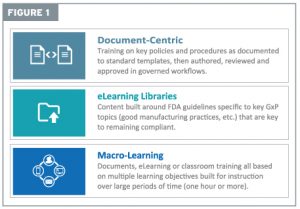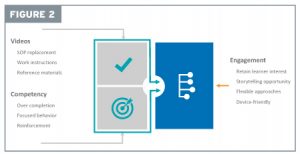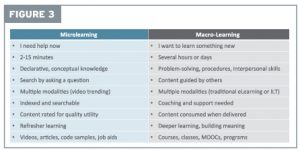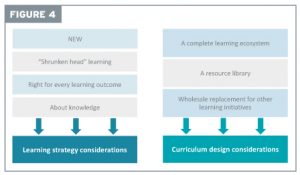FEATURE STORY – By John Constantine and Kent Malmros
Microlearning for Macro-Compliance
Microlearning is a solution that compliance trainers should take note of.
Compliance training is a fact of life in the life sciences industry, something we all know and love (loathe) and “put up” with the best we can. A couple of things that compliance training does:
- “Keeps the lights on” – helps necessary regulated operations moving forward.
- Keeps us all “out of jail” – helps keep us all from running afoul of a myriad of rules and regulations.
A couple of things compliance training does not often do:
- Make us more skilled in our roles.
- Make the company money.
Often called a “necessary evil,” compliance training helps us navigate complex, necessary regulations and generally accepted practices and principles and do business ethically. So why do we groan about it so much?

Part of the answer to this question is almost an axiom – the load or employee time burden of compliance training always increases. Another part of the answer is that we’ve allowed compliance training to become formulaic, non-engaging and not always relevant (over-targeting audiences). That’s because the idea of changing compliance training elicits concerns about, well, introducing compliance risk on its own. Traditionally, compliance and GxP training approaches look like the structure shown in Figure 1.
This short article encourages an approach to compliance training that is not yet frequently used in the context of compliance: microlearning. Gaining traction in the life sciences training world through its adoption by commercial and HR training stakeholders, microlearning is a solution that compliance trainers should take note of – why and how it works – and then jump on board.
Common Microlearning Principles
Microlearning is a recent buzzword that is not a “buzz” word. Many fads have come and gone in learning over the years, but this one is sticking because it works. Karl Kapp and Robyn DeFelice, two gurus in this field, define microlearning as “an instructional unit that provides a short engagement in an activity intentionally designed to elicit a specific outcome from the participant.” Microlearning is backed by science, used increasingly in noncompliance training, and results in better learning outcomes and more fun!

The core principles of microlearning are:
- Size. The shorter duration (2-10 minutes) of learner seat time for training materials is the most obvious microlearning attribute.
- Reinforcement. Shorter materials mean more opportunities for use beyond prescriptive assignments, encouraging re-use and reinforcing concepts that audiences struggle with. This concept reveals something essential about microlearning – it is best considered a complement to, not a replacement for, macro-learning.
- Quizzing. Less content can mean shorter, more targeted quizzes to ensure comprehension or competency on key topics. It can also be used as microlearning itself, forcing the recall of key concepts or facts when spaced strategically after delivery of initial training.

- Video. While video is not the only form of microlearning, it is a valuable tool and easy and inexpensive to produce when done in short (2-10 minute) segments. It is also widely recognized as a preferred form of content consumption based on changing consumer habits, thanks to mobile devices. A training group can set up an effective mobile video studio for less than $5,000.
- Creation/Authoring. Fewer resources may be necessary to build a microlearning asset. However, it will require a deliberate strategy to execute. Since microlearning doesn’t replace the broader learning strategy, it should be considered a part of the toolkit from the beginning.
- Delivery. While delivery methods are becoming flexible, they will require a deliberate strategy to be effective. It is important to consider the capabilities of your LMS or other learning technologies before you build.
While none of these concepts explicitly calls out to GxP or compliance trainers, it is possible to see how they can augment existing learning programs. Short videos are an ideal complement to standard operating procedures, particularly when used to reinforce a key concept. Smaller quizzes delivered via spaced assignments after a policy is read and understood can reveal knowledge retention gaps, and therefore, possible compliance risks.
For example, gaining a project management certification requires macro-learning, not microlearning. However, you can ensure that your newly certified project managers have ample continuing education via microlearning to keep their skills sharp. Start with a strategy – write a plan for where you are now, where you want to go and how you want to get there. Focus on delivery, ensuring competence and learner engagement (see Figure 2).

There is a growing life sciences industry adoption of microlearning, as:
- Learning science demonstrates a 17% increase in learning transfer and 50% higher learner engagement.
- Most importantly, for compliance, it fits in with modernizing concepts of Quality 4.0 and training.
- It fits well into the FDA’s move away from systems validation to systems assurance.
If microlearning effectively engages learners (50%), why wouldn’t you incorporate it into the existing quality and compliance training? Why wouldn’t you complement existing training materials with reinforcement assets (video work instructions)?
The Solution
Figure 3 shows a snapshot of what microlearning looks like vs. macrolearning. There are some considerations from the perspective of learning strategy and curriculum design.
Microlearning can be a crucial strategy to increase learning retention and learner engagement and reduce the staff’s training load, thereby opening up bandwidth for core projects and activities that make us better in our roles and increase compliance. Some care should be taken, however, to be thoughtful and use microlearning where it works best.
Some things that microlearning is not are shown in Figure 4.
Microlearning can be an important addition to your compliance and GxP training toolbox when applied in a strategic, thoughtful manner. When applied to the GxP/compliance training landscape, you may get great feedback from your learners instead of groans in the future.
John Constantine is senior vice president, talent solutions, for Orchestrall and served on the LTEN Board of Directors for 14 years, including two years as president. Email John at john.constantine@orchestrallinc.com. Kent Malmros is senior director, vault training, for Veeva Systems. Email Kent at kent.malmros@veeva.com.








